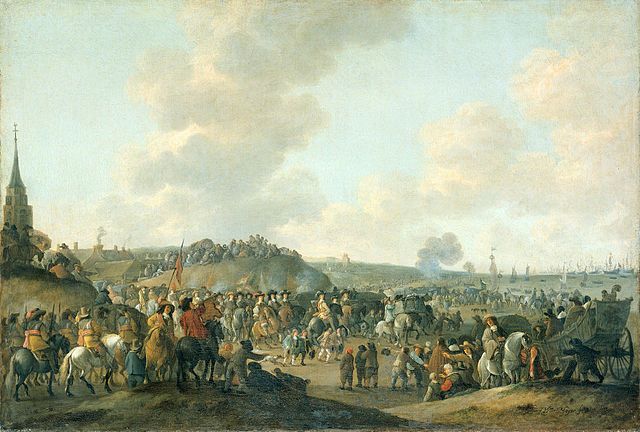
April 10, 2018, by Harry Cocks
Celebrating the Restoration in England’s Towns
On the 8th of May 1660 Charles II was restored to the English throne. Although he did not enter the capital until the 29th, the whole month was given over to lavish ceremonial display. The proclamation of the Restoration was first read in parliament before being taken through the streets of London in procession by the Lords and Commons. A ‘numberless number’ of bonfires were made that evening and ‘all the Bells in the City rung’. Comparable scenes of rejoicing were noted in towns across the country. Melton Mowbray burned its bonfires for three days, festivities at Norwich lasted for nearly a week and all of Oxford was reported to be “perfectly mad.” At Norwich it was estimated that “ten thousand [filled] the Cross and all the Market place, besides those that lined the windows’. There was much ‘firing of muskets and Pistols’ in addition to the customary music, drums, bonfires and bells.”
In a new article, (see link below) Amy Calladine argues that these rituals, which often took on a military character, were crucial in reconciling local elites – many of whom had been loyal to the Cromwellian Protectorate – to the new regime. Not only that, but the frequently martial nature of the ceremonies enabled those same elites to show their loyalty to the King. The military imagery employed in these rituals also aimed to dilute the threat of Commonwealth military power, partly by demonstrating the power of royalist gentry and their military resources. The ceremonies often included displays by the county militia, a part-time civilian defence force consisting of officers from the gentry and common militiamen from the respectable middling sort. The return of the militia into the hands of the (royalist) gentry from March 1660 had been of critical importance in the public legitimization of the new settlement. The figure of the marching, celebrating militiaman also provided a helpful alternative to the threatening spectre of the demobilized parliamentary veteran. Equally, the participation of militia, volunteers and professional soldiers could be harnessed to provide a practical and symbolic defence of existing power structures.
The month following April Charles II’s official progress to London was marked by similar celebrations. At Bath in April 1661 “foure hundred Virgins” entered the Abbey church to usher the mayor’s wife to her seat before the sermon. The guildhall was decorated for the occasion with ‘four Streamers bearing the Kings Armes, and the Royal Oak mounted upon the four Pinacles of the Hall’. In many places, wine ran from conduits, bonfires were lit and bells rung, adding to the temporary transformation of the city into a stage. At Cambridge ‘the town was strewed with green herbs, the windows hanged with Tapistry, Pictures and Garlands, with much Plate and Jewels.’
At Nottingham a play, Robin Hood and his Crew of Souldiers, placed the military at the centre of the Restoration by turning the famous outlaw into a formerly rebellious soldier now realising his loyal to the monarchy. In the play, set on the day of another coronation – that of Richard I – Robin quells the mutinous spirit of his merry men in order to swear loyalty to the new king. A messenger from the new regime promises the outlaws “pardon of all past misdemeanors” on condition of joining “forthwith” to “solemnize his happy Coronation” and offer “chearfull and ready submission to his Majesties Laws,” to which Robin and his men happily agree.
The remade Robin Hood symbolized the ways in which the orderly participation of various military groups in Restoration rituals allowed the martial spirit of the period to be harnessed in order to tame the more problematic and ambiguous elements of the political settlement. Military ritual was designed to operate as both a demonstration of loyalty to the state and a confirmation of the well-governed civic community. In this way, the rituals of regime change contributed to a larger process of public legitimization.
Amy Calladine, “Public Ritual, Martial Forms and the Restoration of the Monarchy in English Towns”, Historical Research (Jan 2018)
https://onlinelibrary.wiley.com/doi/abs/10.1111/1468-2281.12217
Top right: Hendrick de Meijer, Charles II’s Departure from Scheveningen (1660)
No comments yet, fill out a comment to be the first

Leave a Reply